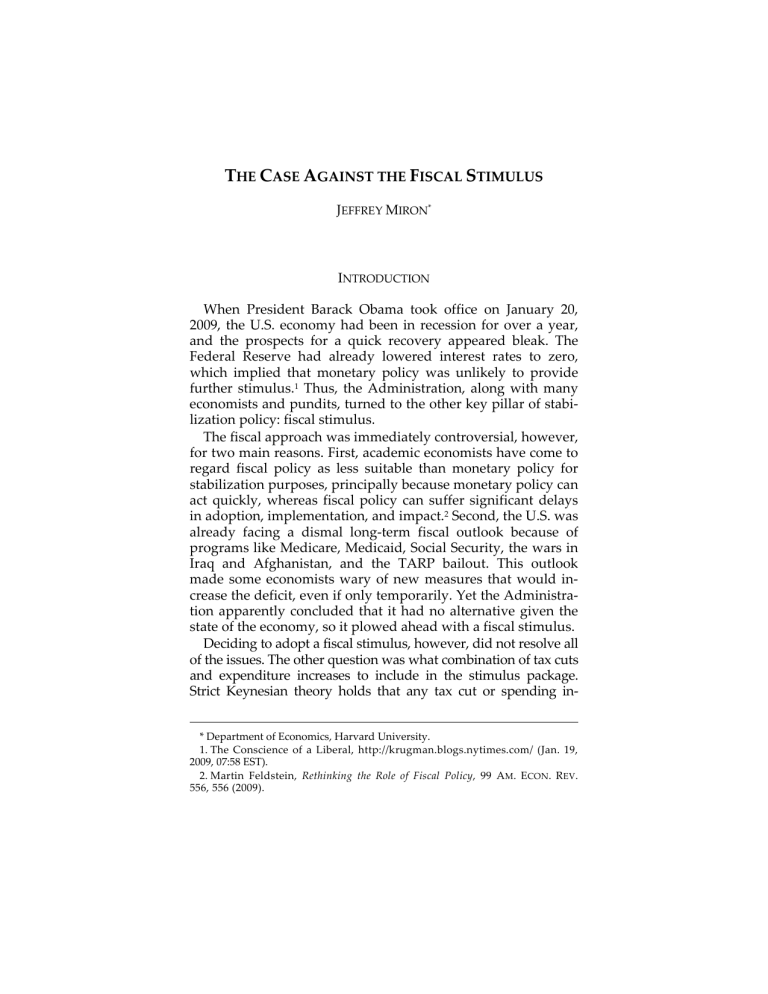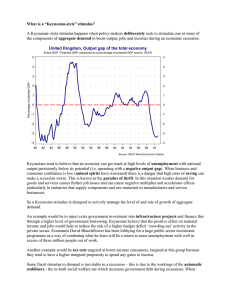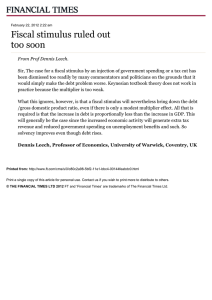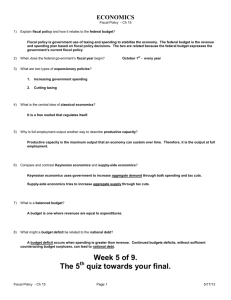
THE CASE AGAINST THE FISCAL STIMULUS JEFFREY MIRON* INTRODUCTION When President Barack Obama took office on January 20, 2009, the U.S. economy had been in recession for over a year, and the prospects for a quick recovery appeared bleak. The Federal Reserve had already lowered interest rates to zero, which implied that monetary policy was unlikely to provide further stimulus.1 Thus, the Administration, along with many economists and pundits, turned to the other key pillar of stabi‐ lization policy: fiscal stimulus. The fiscal approach was immediately controversial, however, for two main reasons. First, academic economists have come to regard fiscal policy as less suitable than monetary policy for stabilization purposes, principally because monetary policy can act quickly, whereas fiscal policy can suffer significant delays in adoption, implementation, and impact.2 Second, the U.S. was already facing a dismal long‐term fiscal outlook because of programs like Medicare, Medicaid, Social Security, the wars in Iraq and Afghanistan, and the TARP bailout. This outlook made some economists wary of new measures that would in‐ crease the deficit, even if only temporarily. Yet the Administra‐ tion apparently concluded that it had no alternative given the state of the economy, so it plowed ahead with a fiscal stimulus. Deciding to adopt a fiscal stimulus, however, did not resolve all of the issues. The other question was what combination of tax cuts and expenditure increases to include in the stimulus package. Strict Keynesian theory holds that any tax cut or spending in‐ * Department of Economics, Harvard University. 1. The Conscience of a Liberal, http://krugman.blogs.nytimes.com/ (Jan. 19, 2009, 07:58 EST). 2. Martin Feldstein, Rethinking the Role of Fiscal Policy, 99 AM. ECON. REV. 556, 556 (2009). 520 Harvard Journal of Law & Public Policy [Vol. 33 crease can stimulate the economy, even if the tax cut is badly de‐ signed and even if the increased spending is for worthless junk.3 If this perspective is right, quibbling about the exact composition of the package is neither necessary nor fruitful. I argue here, however, that the structure of a fiscal stimulus is crucially important and that the package Congress adopted was far from ideal, regardless of the merits of the Keynesian model. Whether countercyclical fiscal policy is beneficial is a more difficult question, but it is not the critical issue if a stimu‐ lus package is properly designed. In fact, the Administration could have created a package that stimulated the economy in the short term while improving economic performance in the long term. This package, moreover, would have been immune to criticism from Republicans. The stimulus adopted was a missed opportunity of colossal proportions. That the Administration and Congress chose the particular stimulus adopted suggests that stimulating the economy was not their only objective. Instead, the Administration used the recession and the financial crisis to redistribute resources to fa‐ vored interest groups (unions, the green lobby, and public educa‐ tion) and to increase the size and scope of government.4 This re‐ distribution does not make every element of the package indefensible, but even the components with a plausible justifica‐ tion were designed in the least productive and most redistribu‐ tionist way possible. The remainder of this Essay is organized as follows. Part I dis‐ cusses the arguments for and against fiscal stimulus. Parts II–IV examine the main components of the stimulus (tax cuts, energy programs, and infrastructure spending, respectively). Part V ad‐ dresses other miscellaneous components. Part VI considers the broader implications of the fiscal stimulus. I. THE KEYNESIAN MODEL The standard justification for a fiscal stimulus relies on the Keynesian model of the economy. This model has been taught to 3. For a standard presentation of the Keynesian model, see N. GREGORY MANKIW, PRINCIPLES OF ECONOMICS 737–826 (5th ed. 2008). 4. See WSJ.com, Getting to $787 Billion, http://online.wsj.com/public/resources/ documents/STIMULUS_FINAL_0217.html (last visited Jan. 27, 2009) (listing more spending on the environment than on tax cuts). No. 2] Case Against the Fiscal Stimulus 521 generations of college students in economics classes around the world, and economists widely—though not universally—accept it as the starting point for analyzing booms and recessions.5 According to the Keynesian model, recessions occur because of a lack of aggregate demand, and government can remedy this shortfall by stimulating demand. On the one hand, government can increase its own demand for goods and services, for example by building more highways, purchasing more military aircraft, or funding additional research and development.6 On the other hand, government can increase demand from consumers and firms by reducing taxes or increasing transfers.7 Although the Keynesian model of fiscal stimulus is widely accepted, it remains controversial as a justification for policy interventions. The first difficulty with Keynesian fiscal stimulus is that the lag between recognition that an intervention might be necessary and the impact of that intervention is likely to be long and variable, so policy can easily end up stimulating when it should be contracting, or vice versa.8 Thus, the practice of coun‐ tercyclical policy is likely difficult even if the theory is unassail‐ able. Over the past several decades, most economists have there‐ fore gradually emphasized monetary policy as the more appropriate tool for countercyclical policy. Lags in monetary policy—although still relevant—tend to be shorter on average.9 The current recession, for example, began in December 2007, yet the fiscal stimulus was not adopted until February 2009, and much of the planned spending will occur in 2010.10 The second issue is that, although Keynesian theory says that the choice of spending projects does not matter, spending on projects that meet standard cost‐benefit criteria makes the most sense and ensures the best use of taxpayer resources in the short term. Further, temporary programs may become long term or permanent given the political difficulties of eliminating government programs. 5. See MANKIW, supra note 3, at 737–826. 6. See id. at 787–88. 7. See id. at 792–93. 8. See id. at 830–31. 9. Feldstein, supra note 2, at 556. 10. Brian Wingfield & Joshua Zumbrun, Stimulus? Yes, in 2010, FORBES.COM, Jan. 28, 2009, http://www.forbes.com/2009/01/28/economy‐stimulus‐unemployment‐ congress‐business‐washington_0128_stimulus.html. 522 Harvard Journal of Law & Public Policy [Vol. 33 Even if significant numbers of productive projects exist, us‐ ing them to stimulate the economy is difficult. Identifying the right projects, planning them appropriately, and undertaking them at a sensible pace can take years, not months or weeks. Thus, the desire for good projects conflicts with the desire to undertake new spending quickly. Beyond these problems, the standard Keynesian defense of fiscal stimulus fails to recognize that attempts to stimulate might exacerbate recessions or have negative long‐term impli‐ cations, even if the Keynesian model is essentially correct. The lower taxes and higher spending required by the Keynesian approach mean increased taxes at some future date, assuming the government balances its budget on average.11 This higher taxation implies more distortions from taxation and therefore lower productivity.12 The stimulus approach generates uncer‐ tainty about which programs the government will support, and this uncertainty can impede private productive activity. The realization that government is handing out pots of money gen‐ erates rent seeking and other unproductive behavior, leading to crony capitalism (for example, a semi‐nationalized auto in‐ dustry). Finally, a belief that government can moderate or eliminate recessions can encourage excessive risk taking and thereby generate instability. Before adopting a fiscal stimulus, therefore, it is imperative to consider the evidence for the Keynesian model’s validity. As it turns out, the empirical support for the Keynesian view is far from compelling.13 The model implies that the impact of in‐ 11. See John F. Cogan et al., New Keynesian Versus Old Keynesian Government Spending Multipliers 7 (Nat’l Bureau of Econ. Research, Working Paper No. 14782, 2009), available at http://www.nber.org/papers/W14782. 12. See Martin Feldstein, The Effect of Taxes on Efficiency and Growth 18–20 (Nat’l Bureau of Econ. Research, Working Paper No. 12201, 2006), available at http:// www.nber.org/papers/W12201. 13. See, e.g., Alberto Alesina et al., Fiscal Policy, Profits, and Investment, 92 AM. ECON. REV. 571, 573–74, 579 (2002) (explaining ambiguous effects on output and investment from government spending); Alberto Alesina & Silvia Ardagna, Tales of Fiscal Adjustments, 27 ECON. POL’Y 488, 508–09 (1998) (examining empirical data indicating anti‐Keynesian effects from tax cuts); Christina D. Romer & David H. Romer, The Macroeconomic Effects of Tax Changes: Estimates Based on a New Measure of Fiscal Shocks, AM. ECON. REV. (forthcoming) (indicating that tax cuts have large, positive multiplier effects); Alberto Alesina & Silvia Ardagna, Large Changes in Fiscal Policy: Taxes Versus Spending 13 (Nat’l Bureau of Econ. Research, Working Paper No. 15438, 2009) (finding that “controlling for initial conditions, a one per‐ centage point higher increase in the current spending to GDP ratio is associated No. 2] Case Against the Fiscal Stimulus 523 creased spending should be greater than the impact of tax cuts, but the existing evidence suggests the opposite.14 Indeed, some empirical evidence finds minimal impacts of spending, but most research finds a robust impact of tax cuts.15 Plausibly, the tax cuts are effective because cuts in the marginal tax rates op‐ erate to increase efficiency regardless of their effect within a Keynesian framework. Thus, even if one takes the basic Keynesian framework as given and accepts that government should stimulate during recessions, existing evidence suggests that an effective package should consist of lower taxes, especially decreased tax rates.16 This approach is likely to be beneficial whether or not the Keynesian analysis is correct because reductions in tax rates improve the incentive to work, save, and invest. This increased efficiency means higher productivity and income, so the net impact on the deficit can be smaller from a well‐designed tax cut than from increased spending. Another way to describe the choice between spending and tax cuts is to note that under increased spending, the political process decides how to spend the money, whereas under tax cuts, consumers and firms get to decide how to spend the money. Thus, the crucial difference between the two ap‐ proaches is not whether one accepts the Keynesian model but whether one believes governments or markets make the best decisions about allocating resources. With this perspective, I with a 0.75 percentage point lower growth”); Alan J. Auerbach & William G. Gale, Activist Fiscal Policy to Stabilize Economic Activity 22, 24 (Nat’l Bureau of Econ. Re‐ search, Working Paper No. 15407, 2009) (indicating that government spending has a smaller impact on investment than tax cuts); Robert J. Barro & Charles J. Redlick, Macroeconomic Effects From Government Purchases and Taxes 26–28, 31–32 (Nat’l Bureau of Econ. Research, Working Paper No. 15369, 2009) (indicating that tax cuts have a GDP multiplier greater than one, whereas defense spending has a GDP multiplier of 0.6–0.7); Andrew Mountford & Harald Uhlig, What Are the Ef‐ fects of Fiscal Policy Shocks? 3 (Nat’l Bureau of Econ. Research, Working Paper No. 14551, 2008) (finding tax cuts provide stronger stimulus than government spend‐ ing); Valerie A. Ramey, Identifying Government Spending Shocks: It’s All in the Timing 27 (Oct. 2009) (unpublished manuscript, on file with University of Cali‐ fornia, San Diego) (finding that government spending has a multiplier between 1.0 and 1.1 and results in a negative wealth effect). 14. See Mountford & Uhlig, supra note 13, at 3; see also Olivier Blanchard & Roberto Perotti, An Empirical Characterization of the Dynamic Effects of Changes in Government Spending and Taxes on Output, 117 Q. J. ECON. 1329, 1347 (2002). 15. Mountford & Uhlig, supra note 13, at 3. 16. See id. 524 Harvard Journal of Law & Public Policy [Vol. 33 now consider the specific elements in the stimulus bill that Con‐ gress adopted and President Obama signed. II. TAX CUTS AND TRANSFER INCREASES The largest components of the stimulus bill are tax cuts and transfer increases aimed at low to moderate income house‐ holds.17 This category included a payroll tax credit in 2009 and 2010, an increase in the alternative minimum tax floor, in‐ creased spending on Medicaid, extended unemployment bene‐ fits, and more money for food stamps.18 A few tax cuts were aimed at businesses, including a provision to allow deductions of current losses against profits made in earlier years.19 The crucial feature of these changes in tax and transfer policy is that most were not reductions in tax rates and therefore did not improve incentives. Some of these provisions are neutral regarding incentives. For example, payroll tax credits and checks sent to Social Security recipients are lump‐sum redistri‐ butions. Yet many other changes, such as extended unem‐ ployment insurance and additional spending on Medicaid, re‐ duce the incentive to work. They are not reductions in tax rates, which are desirable under both the Keynesian and cost‐benefit views of fiscal stimulus. What changes in tax policy would have been sensible from both the Keynesian and efficiency per‐ spectives? Two in particular stand out. The single best change would have been elimination of the cor‐ porate income tax. This component of the current tax system is utterly misguided, independent of Keynesian considerations. The corporate income tax means double taxation of corporate income, which distorts the incentive to save and invest, thereby lowering productivity and growth. The corporate income tax adds a huge level of complexity to the tax code, reducing the transparency of corporate accounting. The standard defense of this tax relies on a desire to redistribute income and assumes that the tax falls on high‐income taxpayers because they own a disproportionate share of corporations. The tax, however, likely affects labor as 17. Getting to $787 Billion, supra note 4 (listing over $200 billion in individual tax cuts and less than $10 billion net business tax cuts). 18. Id. 19. Id. No. 2] Case Against the Fiscal Stimulus 525 much or more than shareholders, especially because corporate income taxation drives corporate activity overseas. In addition to making sense on cost‐benefit grounds, a reduc‐ tion in corporate taxation is entirely consistent with the Keynesian framework. Yet, because it also improves incentives, it should increase output over and beyond any Keynesian im‐ pact. This increased efficiency would generate higher output and tax revenue, so future tax hikes could be less than the cut in the corporate income tax and still balance the budget. A second change in tax policy that makes sense from both the Keynesian and cost‐benefit perspective is a reduction in employment taxes such as those for Social Security or Medi‐ care. This would lower the costs of hiring workers, thereby stimulating increased employment. This change would also improve economic efficiency because employment taxes are a wedge between worker willingness to work and firm willing‐ ness to hire. A reduction in employment taxes would especially benefit low‐ to moderate‐income workers, precisely the group targeted by the other policies in the stimulus package. Taxes dedicated to Social Security and Medicare are, in any case, not good policy. They exist to perpetuate the myth that any given individual’s contributions pay for that individual’s benefits, but because the systems are run on a pay‐as‐you‐go basis, this story is just political spin. Eliminating these separate taxes, and if necessary raising other taxes, would produce a simpler and more transparent tax system. The bottom line on tax cuts and transfer increases is that an al‐ ternative package, focused especially on reducing or eliminating the corporate income tax and on lowering employment taxes, would have been at least as defensible from the Keynesian per‐ spective and far more desirable from the efficiency perspective. The Administration missed an excellent opportunity to reduce or eliminate these undesirable features of the current tax code. III. SPENDING TO PROMOTE ENERGY EFFICIENCY The second major component of the stimulus package is pro‐ grams to increase energy efficiency. These include tax credits for investments in renewable energy, funding for a smart elec‐ tric grid, upgrading government vehicles to be more energy 526 Harvard Journal of Law & Public Policy [Vol. 33 efficient, funding for states to undertake energy efficiency pro‐ grams, and so on.20 Advocates of these particular programs ar‐ gue that increased energy efficiency reduces air pollution, low‐ ers reliance on foreign oil, and slows global warming. Even if these claims are valid, however, government attempts to in‐ crease energy efficiency are problematic components of a fiscal stimulus package. First, many of these programs require time to plan and im‐ plement properly, so spending either occurs too late to coun‐ teract the recession or risks being done badly because it is rushed. A second problem is that energy‐efficiency programs are not likely to use unemployed resources. Instead, they merely shift employment from existing uses to government uses. This makes it even more important that the increased spending go to projects that pass a standard cost‐benefit test, which is again difficult when the spending is rushed. The third problem is that energy‐efficiency programs are in‐ effective methods of reducing energy use. Consider upgrades of the federal government’s vehicle fleet. Hybrid cars require less energy to operate than standard cars, but hybrids cost more than standard cars, and these higher costs result in part from additional energy required for their manufacture. Thus, upgrading the fleet might not reduce energy use and could even increase it. Rather than trying to promote energy efficiency with slow‐ acting and ineffective energy programs, the right approach is higher energy taxes, which directly raise the price of energy and discourage its use. Much of the infrastructure necessary to collect these taxes already exists.21 The degree to which energy taxes raise prices is observable. Thus, gauging the magnitude of the intervention is straightforward. The right way to reduce energy use and stimulate the econ‐ omy, therefore, is to increase energy taxes while lowering other taxes enough to offset the higher energy taxes and provide the desired amount of stimulus. 20. Id. 21. Kenneth P. Green et al., Climate Change: Caps vs. Taxes, AM. ENTERPRISE INST. ENVTL. POL’Y OUTLOOK 1, 6 (2007), available at http://www.aei.org/outlook/26286. No. 2] Case Against the Fiscal Stimulus IV. 527 SPENDING ON INFRASTRUCTURE The third main component of the stimulus package is expen‐ ditures on infrastructure, such as roads, railways, and public transportation.22 In addition to the Keynesian justification, the argument for this spending is that many infrastructure projects generate benefits in excess of costs and are not produced effi‐ ciently by the private sector. The issues raised by this component of the stimulus are simi‐ lar to those raised by energy‐efficiency programs. Choosing the right projects and implementing them properly takes time, yet fiscal stimulus needs to happen quickly. Some infrastructure spending merely shifts employment from other activities, rather than putting the unemployed to work. Political influ‐ ences promote the projects in districts of key congressmen rather than those with the greatest ratio of benefits to costs. The question for infrastructure spending, moreover, is not whether some amount is beneficial; the question is whether additional spending on infrastructure is productive, given the amounts already being spent. If most of the beneficial roads have already been built (for example, those connecting major centers of population in densely populated parts of the coun‐ try), then new roads will be highways to nowhere and a waste of economic resources. V. OTHER COMPONENTS OF THE STIMULUS PACKAGE Beyond the main components discussed above, the stimulus package includes a broad range of smaller projects. These pro‐ jects raise similar issues to those discussed above, so a detailed analysis is not necessary. A few brief comments are neverthe‐ less in order. A significant component of the stimulus bill was increased expenditure for scientific research.23 The incentives to invest in research are potentially insufficient from the perspective of soci‐ ety overall, and the case for government subsidies is reasonable. But the right question is whether the United States needs sub‐ 22. Getting to $787 Billion, supra note 4. 23. Id. 528 Harvard Journal of Law & Public Policy [Vol. 33 stantial additional government funding relative to its 2009 fund‐ ing levels. The Administration offered no evidence to support this claim. It just assumed that because research is good, more is better. Research spending is again unlikely to use unemployed resources and instead enriches those already employed while shifting research activity from the private sector to government. Another substantial chunk of the stimulus consisted of trans‐ fers to state governments,24 some of which took the form of block grants. This shift of spending from the federal govern‐ ment to the states is potentially desirable because it means less centralized decision making. The lion’s share of the transfers, however, was to public education.25 The stated goal was to re‐ duce teacher layoffs,26 and that undoubtedly occurred to some degree. Yet many school districts have excess personnel (assis‐ tant principals, specialists for everything), and layoffs might be appropriate. Some of the federal money will end up as higher wages for unionized teachers. States, moreover, could improve education on their own via charters and vouchers, reducing costs without federal infusions. Thus transfers to states would have been defensible if unconstrained, but they mostly were not. CONCLUSION A few weeks after President Obama’s victory in the 2008 election, adviser Rahm Emanuel quipped that “[y]ou never want a serious crisis to go to waste . . . [because it] provides the opportunity for us to do things that you could not do before.”27 Emanuel was correct: The situation in which the new Admini‐ stration found itself constituted an unusual political dynamic that, properly used, would have allowed the Obama Admini‐ stration both to stimulate the economy and make it more pro‐ ductive over the long haul. The Administration should have endorsed a stimulus package based on a repeal of the corporate income tax and reductions in employment taxes. This policy would have accomplished its stated goals, and the budgetary implications would have been 24. Id. 25. Id. 26. Id. 27. Tom Raum, Analysis: Confirmation of recession may strengthen Obama’s push for anti‐recession package, ASSOCIATED PRESS, Dec. 2, 2008. No. 2] Case Against the Fiscal Stimulus 529 less negative than those of the package ultimately adopted be‐ cause this alternative plan would have enhanced rather than de‐ tracted from economic efficiency. This approach would also have been difficult for Republicans to oppose. Yet the Administration did not take this approach, presuma‐ bly because its true goals were not just economic stimulus. In‐ stead, the Administration wanted to reward its constituencies (unions, environmentalists, public education) and increase the size and scope of government. This tactic is consistent with the Administration’s policies in general. Across the board, it has taken a big government, redistributionist approach, whether re‐ garding housing, unions, health, the auto industry, trade, anti‐ trust, or financial regulation. The Administration’s view appears to be that government is better than individuals at deciding how taxpayers get to spend their money and that government should engineer large transfers from richer to poorer. Whether the Administration’s stimulus package will be suc‐ cessful is still to be determined. If the extra spending ends up being productive, then the impact of the stimulus might be positive on net. My own prediction, however, is that the pro‐ grams adopted will generate large distortions and substantial waste, with minor stimulus impact. This is a pity because much better alternatives were available.






